Corrugated Material and Styles Guide
Grades
In the corrugated industry, there are two different standards for measuring the material for which cartons are constructed with; The Mullen Test and The Edge Crush Test.
The Mullen Test was designed to test the bursting strength of a corrugated box- or how many pounds of pressure it would take to rupture the material. Boxes that are made from material compliant with Mullen Test standards will be labeled with 200 #, 275 #, 350 #, etc. The higher the number, the more durable the box will be. 200 # indicates that the box can withstand pressure of up to 200 lbs per square inch before bursting.
The other standard is called the Edge Crush Test. This test was developed in 1990’s and has gained much popularity for its cost effectiveness. The Edge Crush Test basically measures the stacking strength of the box before it crushes at its edges. Boxes made of this material will be labeled with 32 ECT, 44 ECT, 48 ECT, etc. Similar to the Mullen Test, the higher the number, the greater the durability of the carton.
So what's the difference?
For the typical consumer, 200 # and 32 ECT are practically interchangeable. However, 200 # is a bit heavier, thus more expensive. If your carton is going to be subjected to a long shipment or heavy damage, you may consider paying the extra cost for 200 # C. However, for general, everyday use, 32 ECT-C is both durable and cost effective.
Board Styles
SINGLEFACE: One medium is glued to one flat sheet of linerboard. This style is used for interior packing only and can be a great tool for padding items for shipping.
SINGLEWALL: One medium is glued between two sheets of linerboard. This is most common type of board and is available in an array of different strengths.
DOUBLEWALL: Two corrugated mediums in between three pieces of linerboard. This style is designed for holding/stacking heavier items and items that may be subjected to a lot of damage. (Composed of B and C Flutes, see below)
TRIPLEWALL: Three mediums between four sheets of linerboard. Triple wall packing is most commonly used for heavy, bin-style boxes in industrial settings. It is the strongest style for cartons. (Composed of two layers of C Flute and one layer of B Flute, see below)
Flutes
B: B FLUTE corrugated board is 1/8 inch thick and is typically used for smaller cartons. It is a good surface to hold print and is easily folded into intricate shapes.
C: C FLUTE is by far the most common form of corrugated board. It is suitable for holding print and is durable enough for normal shipping and everyday use. It is a little thicker than B Flute at 3/16ths inch.
E: E FLUTE is much thinner than B or C at 3/32nds of an inch thick. This board is typically only used for smaller cartons. Due to the close fluting, it is excellent board for printing. Pizza boxes are typically made from this type of board.
*For other specialty types of board please contact your area's sales representative.
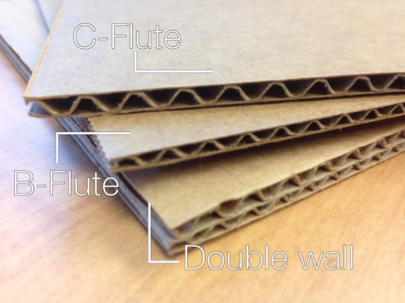
Common Carton Styles
RSC (Regular Slotted Container)
Most common style of carton. All flaps are the same length and all meet in the center of the box when folded.
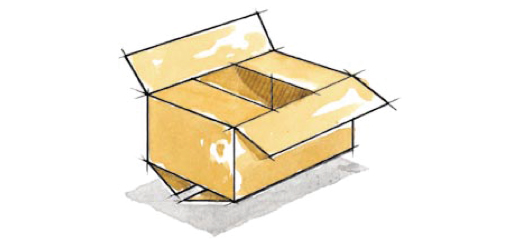
HSC (Half Slotted Container)
Similar to an RSC but is missing one set of flaps. This design can be left open on one side or ordered with a lid.
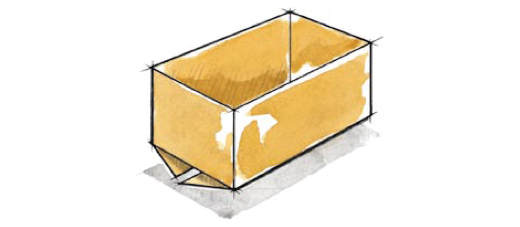
FOL (Full Overlap Container)
All flaps have the same length that is equal to the width of the box. The overlapping flaps provide extra support and padding.
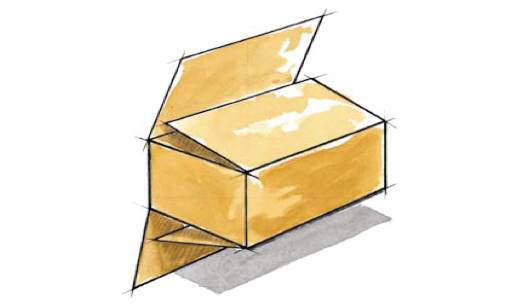
OPF (One Piece Folder)
One piece of corrugated board is cut to provide a flat bottom with flaps forming on the sides and meeting on the top.
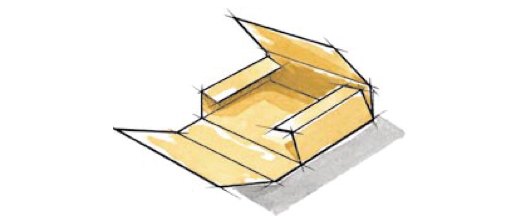
The styles listed above are the most basic corrugated styles. For more styles and options (including print and die cut options), please contact customer service and get started with your design today!

